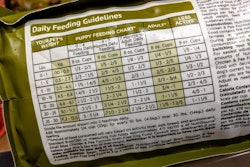
Data for U.S. pet food exports through November 2018 show good year-over-year growth, but the country’s global share of exports continues to decline, said Gina Tumbarello, director of international policy and trade for the American Feed Industry Association (AFIA), during its 12th Annual Pet Food Conference, held February 12 in conjunction with the International Production and Processing Expo in Atlanta, Georgia, USA.
U.S. exports from January to November, the last month full data is available, reached about 700 thousand metric tons (TMT). That compared favorably to the data for January-November 2017 of about 660 TMT, Tumbarello said. The 2017 total ended up at 715 TMT, according to her data. The peak was 2013, when U.S. pet food exports hit 747 TMT, or U.S.$1.46 billion. (She didn’t provide value amounts for subsequent years.)
U.S. third in global pet food exports
The U.S. share of global pet food exports has also continued to decline from a high of 10.9 percent in 2013. Its share for 2017 was 9.2 percent, down from 9.5 percent in 2015 and 2016 and placing it third globally behind France and Germany. France’s share has also decreased, while Germany’s is on the rise, up to 11.1 percent for 2017.
While France and Germany export pet food mainly to other European Union (EU) countries, the U.S. counts markets in Latin America and Asia among its top export markets – yet Asia is also the source of increasing competition for the U.S., Tumbarello said, from Taiwan and other countries there.
Another factor affecting U.S. pet food exports is international trade agreements, which could offer U.S. pet food companies an opportunity to compete more fairly on a global scale. “There are international grade agreements that the U.S. is not part of, which hurts our industry,” Tumbarello said.
Canada is by far the largest market for the U.S., with its 273 TMT through November 2018 comprising a 90 percent share of all U.S. pet food exports. Rounding out the top five markets for the U.S.: Japan, at 60 TMT; Mexico, 52; Australia, 31; Hong Kong, 23. (All data are through November 2018.)
Update on China tariff war, impact on pet food
U.S. pet food exports to China were ensnared in the escalating tariff war between the two countries in mid-2018, with the tariff on pet food imported into China jumping from 4 percent to 29 percent, Tumbarello said. Pet food producers already faced significant barriers getting their products into China, she added; for example, China still bans any pet foods from the U.S. testing positive for ruminant tissue because of BSE concerns, even though there have been no instances of BSE in the U.S. since 2012. While pet food companies’ own ruminant test results are completely negative, the same products often turn up with positive tests in China, possibly due to differences in testing methods. (AFIA is working with the U.S. Department of Agriculture’s Animal and Plant Health Inspection Service, APHIS, to address this problem, Tumbarello said.)
The next deadline regarding the tariff situation is March 1. If the U.S. and China have not reached an agreement or at least made sufficient progress in tariff negotiations, the Trump administration is set to increase tariffs on a number of Chinese goods, and China would no doubt retaliate, Tumbarello said. Among the products from China that likely would be affected by new U.S. tariffs are some vitamins used in pet foods that are available only from China.
Make your concerns, interests heard
Pet food is also affected by other tariff and trade situations the U.S. is or could be entering, including the new USMCA agreement (essentially replacing NAFTA), plus possible new negotiations that could be undertaken with Japan, the EU and the UK in the aftermath of Brexit, Tumbarello said. She urged pet food producers to make sure their interests, concerns and experiences are heard, including through AFIA membership.

















